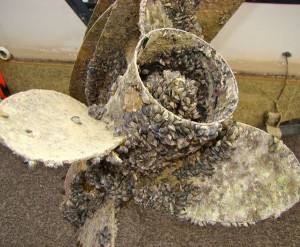Invasive species a constant threat in the West

Quagga mussels like these on a boat prop leaving Lake Mead are what officials want to keep out of uncontaminated lakes. Photo/TRPA
By Anne Knowles
Invasive species cost the country $3 billion every year and none more so than the fast-growing quagga mussel.
“The quagga mussel is the most costly invasive in U.S. history,” said Matt Morrison, chief executive officer of the Pacific Northwest Economic Region, during a webinar last week titled Critical Habitat and Invasive Species hosted by the Western Governors’ Association.
Morrison said the tiny, fingernail-sized mussels, which can reproduce up to a million offspring annually, are in everywhere except the Pacific Northwest.
They latch onto any hard surface and not only affect fish such as salmon, but agriculture and water infrastructure as well, including hydropower operations like the 60 located throughout the Pacific Northwest.
And once the mussels enter a system, they are there to stay.
“They’ve never been eradicated,” said Morrison. “That’s just not an option.”
That’s why agencies in Lake Tahoe do all they can to prevent the tiny mussels from ever entering its waterways.
Every boat entering Lake Tahoe is required to be inspected, unless it bears a Tahoe-only tag that certifies the lake is the only water the boat enters, said Chris Crookshanks, native aquatics staff specialist with the Nevada Department of Wildlife.
“As soon as the mussels were discovered in the lower Colorado (in Lake Mead) the Lake Tahoe basin spent a lot of money to implement measures to prevent them,” said Crookshanks.
Research done last year by UNR and the Desert Research Institute found that quagga mussels could thrive in Lake Tahoe despite the lake’s low calcium levels.
Crookshanks spends time on recovery of Lahontan cutthroat trout, which are threatened by nonnative fish species, including rainbow, brown and brook trout that were introduced into water bodies throughout the west, including Lake Tahoe.
Crookshanks said other threats to the native trout in Nevada are water diversions, feral horses, cattle, fire and drought.
He said the key to success in the trout’s recovery are cooperation between various entities such as the Bureau of Land Management, U.S. Forest Service, area Native America tribes and non-governmental organizations such as Trout Unlimited as well as private landowners through safe harbor agreements.
Those successes don’t include Lake Tahoe.
“It is so big we’ll never see recovery of Lahontan cutthroats there,” said Crookshanks. That has not stopped agencies on the California side, though, from trying to bring back the native species.
Technically, a useful method has been to start at the top of a water system, install temporary barriers, work to control nonnative fish populations, then remove the barriers and work on the next stretch of the system, said Crookshanks.
“That’s a great strategy, but there are some systems where the temporary barrier has to stay because the next piece can’t be done,” said David Sweet, Yellowstone Lake special project manager with Wyoming Trout Unlimited.
Sweet has worked for years on the effort to restore Yellowstone cutthroat trout, which are preyed upon by nonnative lake trout.
The U.S. Park Service, Yellowstone Park Foundation and NGOs spend about $2.3 million annually on the work, and in the last four years have been able to half the lake trout population and triple the number of Yellowstone cutthroat.
He said the primary methods are netting operations and telemetry to identify lake trout spawning areas and then do alternative suppression.
“Eradication is a term we rarely use, we use suppression,” said Sweet. “Eradication is impossible in a system like a lake or with something like mussels. We reduce the populations and give the cutthroat a chance to survive. … In the future we may be able to talk about eradication through genetic engineering.”


